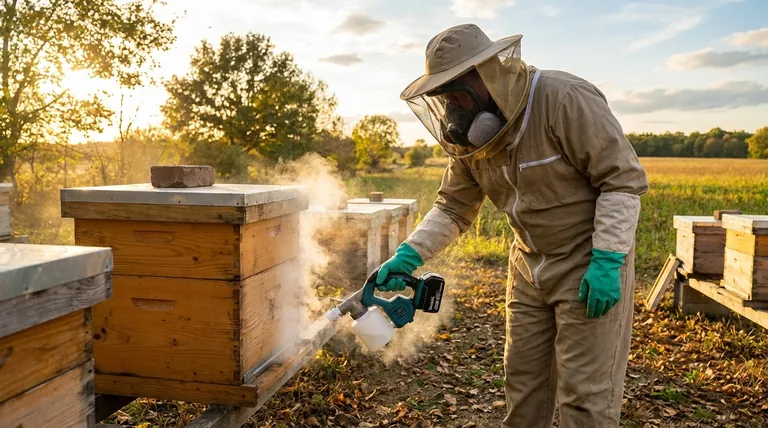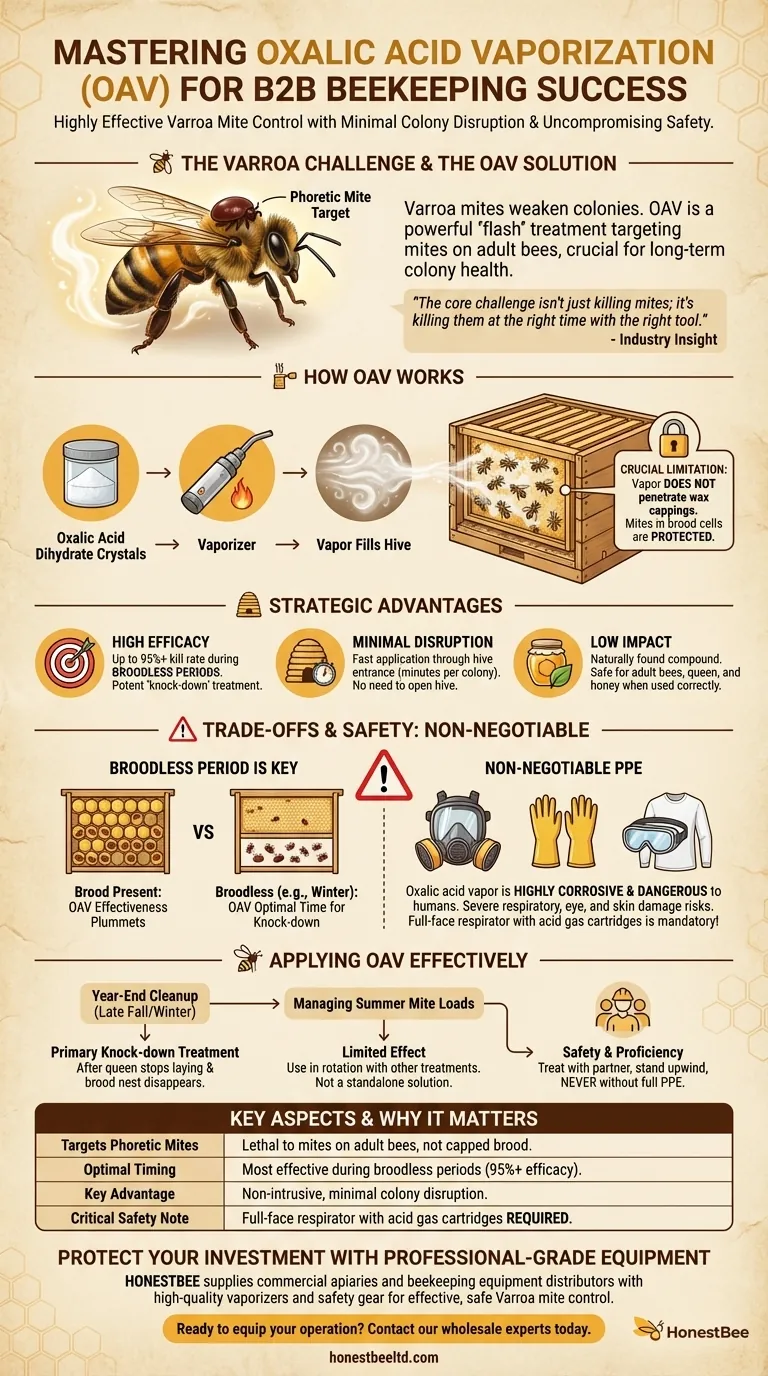Mastering Oxalic Acid Vaporization (OAV) is one of the most important skills a modern beekeeper can learn because it provides a highly effective, efficient, and clean method for controlling Varroa mites. When executed correctly, it drastically reduces mite loads with minimal disruption to the colony, directly impacting the long-term health and survival of your bees.
The core challenge for beekeepers isn't just killing mites; it's killing them at the right time with the right tool. Oxalic Acid Vaporization is a powerful tool, but mastering it means understanding its specific target—mites on adult bees—and adhering to uncompromising safety protocols.

The Role of Oxalic Acid in Varroa Management
Varroa mite control is not optional; it is a fundamental part of responsible beekeeping. Understanding how OAV fits into this strategy is the first step toward mastery.
What is the Varroa Destructor Mite?
The Varroa destructor is an external parasitic mite that attacks and feeds on honey bees. It is the single greatest threat to honey bee colonies worldwide, weakening bees and transmitting deadly viruses. Unmanaged infestations will almost certainly lead to colony collapse.
How Oxalic Acid Vaporization Works
The process involves heating oxalic acid dihydrate crystals in a specialized tool called a vaporizer. This transforms the solid crystals into a fine vapor that fills the entire hive cavity. This vapor coats the bees and hive surfaces.
Targeting Phoretic Mites
OAV is a "flash" treatment that is highly effective against phoretic mites—the mites physically attached to the bodies of adult bees. Upon contact, the oxalic acid is lethal to the mites.
Crucially, the vapor does not penetrate the wax cappings of brood cells. This means any mites reproducing within those cells are completely protected from the treatment. This limitation is the most important factor in determining when and how to use OAV effectively.
The Strategic Advantages of Vaporization
When compared to other mite treatment methods, OAV offers several distinct advantages that make it a preferred choice for many beekeepers.
High Efficacy
When applied during a period with little to no capped brood, an OAV treatment can achieve a mite kill efficacy rate of over 95%. This makes it an extremely potent "knock-down" treatment.
Minimal Hive Disruption
A key benefit is the speed and non-intrusive nature of the application. The treatment is administered through the hive entrance, typically taking only a few minutes per colony. You do not need to open the hive or remove any frames.
Low Impact on Bees and Honey
Oxalic acid is a compound naturally found in honey, plants, and vegetables. When used at the correct dosage, it is very safe for adult bees, does not harm the queen, and does not contaminate the honey.
Understanding the Trade-offs and Safety Risks
True mastery requires understanding a technique's limitations and risks. OAV is powerful, but it is not a silver bullet, and it carries significant risks for the beekeeper if handled improperly.
The Broodless Period is Key
Because OAV only kills phoretic mites, its effectiveness plummets if the colony has a large amount of capped brood. A significant portion of the mite population will be safe inside these cells, ready to emerge after the treatment is over. Therefore, OAV is most effective during a natural broodless period, such as in late fall or winter.
The Non-Negotiable Need for PPE
Oxalic acid vapor is highly corrosive and dangerous to humans. Inhaling the vapor can cause severe, permanent damage to the respiratory tract, throat, and lungs. It can also cause serious eye and skin damage.
Mastering OAV means mastering safety. The absolute minimum Personal Protective Equipment (PPE) includes:
- A full-face respirator with acid gas cartridges (P100 rating). A simple dust mask is useless.
- Chemical-resistant gloves.
- Goggles and long sleeves to protect your eyes and skin.
Risk of Colony Harm
While generally safe for bees, improper dosage or repeated treatments in a short period can stress the colony and harm open (uncapped) brood. It is essential to follow established dosage guidelines based on hive size and to integrate OAV into a broader treatment plan.
Applying OAV Effectively in Your Apiary
Use this guidance to decide how to incorporate Oxalic Acid Vaporization into your Integrated Pest Management (IPM) strategy.
- If your primary focus is a year-end cleanup: Use OAV as your primary "knock-down" treatment in late fall or early winter after the queen has stopped laying and the brood nest has disappeared.
- If your primary focus is managing summer mite loads: Recognize that OAV will have limited effect due to the presence of brood. It can be used, but only as part of a rotation with other treatment types that can penetrate brood cappings.
- If your primary focus is safety and proficiency: Always treat with a partner, stand upwind during application, and never, ever perform a treatment without your full, properly-rated PPE.
Mastering this technique empowers you to protect your colonies with a precise and powerful tool, ensuring their health for years to come.
Summary Table:
| Key Aspect | Why It Matters for Beekeepers |
|---|---|
| Targets Phoretic Mites | Lethal to mites on adult bees, but does not penetrate capped brood cells. |
| Optimal Timing | Most effective during broodless periods (e.g., late fall/winter) for 95%+ efficacy. |
| Key Advantage | Non-intrusive application through hive entrance; minimal disruption to the colony. |
| Critical Safety Note | Requires full-face respirator with acid gas cartridges; vapor is highly corrosive to humans. |
Protect Your Investment with Professional-Grade Equipment
Mastering Oxalic Acid Vaporization requires reliable, durable equipment. HONESTBEE supplies commercial apiaries and beekeeping equipment distributors with the high-quality vaporizers and safety gear needed for effective, safe Varroa mite control.
Ready to equip your operation? Contact our wholesale experts today to discuss your needs and ensure your colonies thrive.
Visual Guide

Related Products
- Adjustable Formic and Acetic Acid Dispenser for Bee Mite Treatment
- Professional Galvanized Hive Strap with Secure Locking Buckle for Beekeeping
- Economy Small Scale Honey Dryer Dehumidifier Thickening Machine
- Langstroth Screen Bottom Board for Beekeeping Wholesale
- High Quality Honey Dehumidifier Dryer Thickening Machine for Beekeeping
People Also Ask
- How do Varroa mites spread between honey bee colonies? Stop Mite Transmission in Your Apiary
- What should beekeepers do to manage varroa mites effectively? Adopt a Proactive Monitoring Strategy
- What should be done after treating a colony for varroa mites? A Step-by-Step Guide to Verifying Success
- What are the symptoms of Varroa Mite Syndrome (VMS)? Recognizing the Signs of Colony Collapse
- What are phoretic mites? A Beekeeper's Guide to Monitoring Varroa Infestation



















